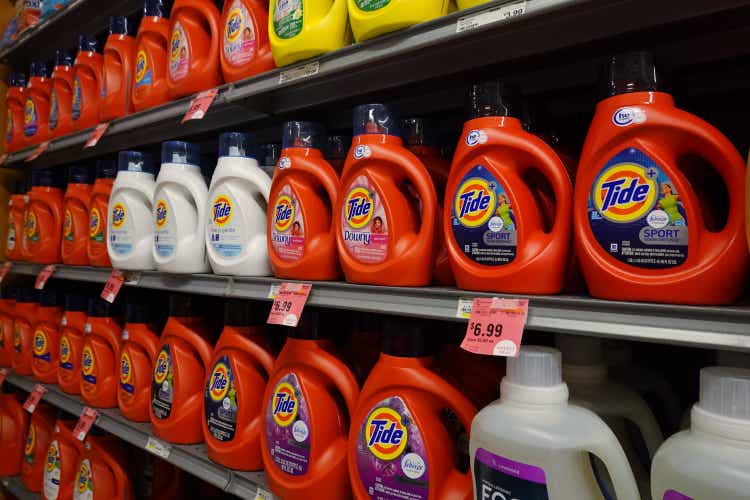Joe Raedle
In April 2020 I called Procter & Gamble (NYSE:PG) a resilient play in the storm which was out there at the time of course, with the pandemic in its early innings.
The company was benefiting from its defensive positioning, selling everyday essentials, as it benefited from a near term hoarding effect as well. Despite the strong performance, I thought the valuations were a bit rich, despite a plunge in interest rates and the fact that opportunities wee arising left and right.
A Solid Play
In April 2020, Procter just posted its third quarter results with volumes up 6%, as adverse currency moves made that total revenues were up a percent less to $17.2 billion. Reported earnings came in at $2.9 billion, up in line with topline sales growth as some modest reduction in the share count allowed for a 10% increase in adjusted earnings to $1.17 per share.
At the time Procter was a $125 stock which was set to earn $5 per share that year, translating into a 25 times earnings multiple. Net debt was posted at $20 billion and change, just surpassing $17-$18 billion in annual EBITDA, giving the company plenty of firepower with no leverage concerns seen in an uncertain period of time, as the overall valuations were quite demanding.
So despite a solid performance in an uncertain period of time, and a strong balance sheet, it was the overall valuation which was too high for me to see appeal and to get involved with Procter.
Performing, And Than Not
After trading at $125 in the spring of 2020, shares have gradually moved higher and hit a high at $165 per share at the start of 2022. What followed has been a big retreat to $125 again, mostly driven by the impact of a strong dollar and rising interest rates.
As it turned out, Procter posted its fiscal 2020 sales at $71.0 billion on which core earnings of $5.12 per share reported in the summer of that year. The year which followed was another solid year, with revenues up 7% to $76.1 billion, as core earnings per share were up 11% to $5.66 per share, the result of higher prices, volumes and a relative weaker dollar (that year). Net debt came in at $21.7 billion, with EBITDA coming in at nearly the same number.
The fiscal year 2022, as released in July, saw a bit more modest growth with sales up 5% to $80.2 billion, yet core earnings per share rose just 3% to $5.81 per share. Slower earnings growth is due to the nature of sales growth, as Procter saw volumes come down 1%, while prices rose 8% and currency moves subtracted some 4 points from reported sales growth. To ignite some earnings per share growth, Procter has continued to pursue share buybacks as this has resulted in a modest built-up in net debt, up to $24.2 billion. Nonetheless, this remains a very manageable amount as EBITDA came in at $20.8 billion on a reported basis last fiscal year.
The 2023 guidance is a bit mixed. Organic sales are seen up 3-5%, but this is likely largely driven by pricing, although the contribution of price and volumes has not been quantified. Currency headwinds are expected to cut sales growth by three points, leaving just a point or two in expected revenue growth. Despite an anticipated $3.3 billion, or $1.33 per share in headwind from inflation in general, in specific freight expenses and currency moves, the company sees adjusted earnings up between one and four points.
With earnings set to come in a few pennies short of $6 per share in the current fiscal year, to which there are clearly some risks, it is needless to say that the earnings multiple has fallen to 21 times earnings. This makes that a 4% earnings yield at 25 times earnings has risen to nearly 5%, likely the result of higher interest rates ever since. Leverage remains very modest, yet the pace of organic growth of Procter is lagging a bit, as the company has seen strong momentum in recent years, after Procter has been regarded as a solid operator in the last couple of years.
And Now?
With shares coming under pressure, the magical 3% dividend yield comes in sight as the annual dividend payout now comes in at $3.52 per share, although the magic of this 3% number is less pronounced as has been the case in more recent times. This of course comes as interest rates have moved up so violently.
A 25% move lower this year is a big move for a consumer staple business like Procter & Gamble, yet the reality is that this move looks probably fair with operating performance cooling down a bit, yet mostly because interest rates have moved up a lot and the earnings and dividend yield of Procter is no longer as competitive.
In the meantime, the outlook for 2023 shows that Procter is a defensive name. Even in this difficult and inflationary environment, which is set to hurt earnings by more than a dollar per share if no actions are taken (to cut earnings per share by some 20%), the company expects to offset inflationary pressures and expects earnings per share to rise by a few pennies in a tough environment. It is exactly this quality why investors like Procter.
Hence, like is the case for more dividend names and consumer staple companies, shares look more interesting, yet they have to compete with high interest rates being available in this environment. While rates can bring Procter’s shares all over the place in the near term, this seems like a solid long-term dividend play.


Be the first to comment